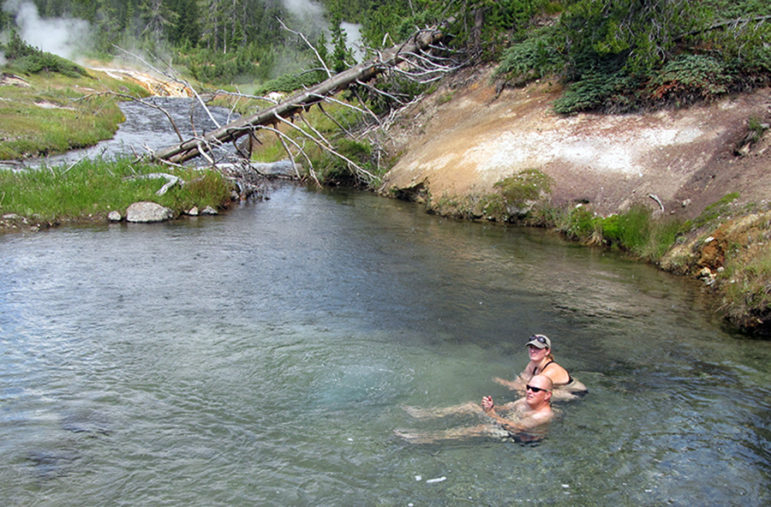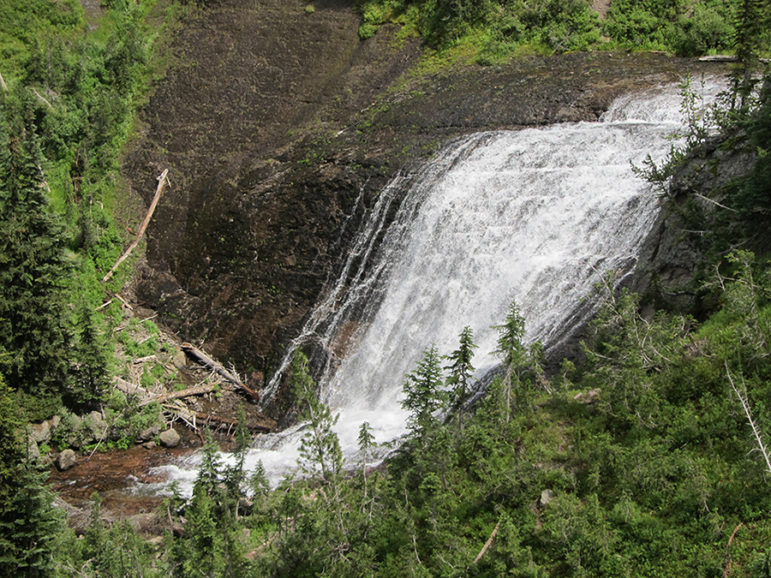
I leaned over the water with trepidation, looking at the bubbles gurgling from the middle of the pool. I put my hand over the water, straining to feel how much heat it emitted. Then I put in my toe.
My hiking partners and I knew Mr. Bubbles was one of the few places in Yellowstone National Park you can soak without being boiled alive. That’s why we’d hiked more than 16 miles the day before through the backcountry. But years of warning about Yellowstone’s thermal features and a recent discussion about the book “Death in Yellowstone” had us all exercising extra caution.
There are few areas in Yellowstone where you can take advantage of the features that make the park famous. Most hot springs in the park are too hot or too acidic for people to use, said Lee Whittlesey, park historian. But located in the Bechler area in the southwest corner of Yellowstone, a place famous for its waterfalls, two alkaline thermal features mix with the cold water of the Ferris Fork River and create a hot spring worthy of the long hike in.

Soaking and swimming in the park’s thermal features is illegal in Yellowstone. But like the popular Boiling River near Gardiner, Montana, at Mr. Bubbles you are technically soaking in the river. The pool-like feature made from rocks that form a dam on the Ferris Fork gets its name from a fumarole below the water that releases big bubbles. A fumarole is a steam vent, or crack in the ground that releases thermal heat, Whittlesey said.
If a fumarole is on land, it steams. If the area is muddy, it becomes a mud pot. If it’s in the water, it creates a hot spring.
Another nearby thermal feature also dumps hot water into the cold river at the same spot, mixing to make it soaking temperature.
Whittlesey doesn’t know who discovered Mr. Bubbles, or when. He first visited it in the 1970s. Back then it was called “Nirvana Pool.” It’s remained remarkably stable since then.
A few years ago the park closed Mr. Bubbles for most of the summer after a suspected natural explosion on the side of a nearby hill started pouring in extra water, making it too hot for people to soak, Yellowstone backcountry program manager Ivan Kowski said. By the following year it was safe again, but things in the park area always changing.
The area used to be one of those secret Yellowstone spots shared only with close friends, but through the years word spread and it’s become a popular spot — as popular as Yellowstone’s backcountry gets. We saw no one during our mid-morning soak and only a few other parties during our three days on the trail.
But reservations for campsites near Mr. Bubbles fill quickly with people approaching it both from the Bechler Ranger Station and Old Faithful, Kowski said.
While the area is technically open year-round and some people even ski in during the winter, the backcountry office doesn’t make reservations before July 10 because the rivers are so high, and flooding makes it inaccessible. The high point of the trail is the Continental Divide at 8,500 feet and snow can last into the summer months.
Our hike in was beautiful with classic Western scenery — waterfalls, rivers and wildflowers along with a few gurgling pools and steaming streams of water to remind us we were in Yellowstone.
When we ditched our packs for the half-mile hike from the main trail into Mr. Bubbles we entered another world. It felt like we had traveled back to the time of dinosaurs. Steam rose along the river from colorful pools of boiling water. There were dark oranges and vibrant blues jumping out from the greens and browns of the forest.
From the trail we could feel the heat rising from nearby streams and bubbling pools.
You’ll need a backcountry permit for overnight camping. For questions about planning a trip, call the backcountry office at (307) 344-2160. Don’t forget bear spray, and exercise caution around thermal features.
I entered the pool cautiously. I hadn’t thought to bring water shoes and a few hot rocks gave off short bursts of disconcerting heat. I’d just gotten comfortable in a spot with perfect soaking temperatures when an icy blast of river water swirled around me. It was a strange ever-changing mix of hot and cold water.
Then it began to hail, the plopping ice balls making the water further bubble and steam.
I found a warm spot again and settled in. From my vantage point in the pool I watched water rush down the orange and yellow sides of a large thermal feature on the other side of the river. Steam rose from other hidden hot spots along the banks. This, I thought, is why Yellowstone is so special.
Reprinted with permission from “Peaks to Plains” a WyoFile blog focusing on Wyoming’s outdoors and communities. Kelsey Dayton is a freelancer and the editor of Outdoors Unlimited, the magazine of the Outdoor Writers Association of America. She has worked as a reporter for the Gillette News-Record, Jackson Hole News&Guide and the Casper Star Tribune. Contact Kelsey at [email protected] and follow her on Twitter: @Kelsey_Dayton.
